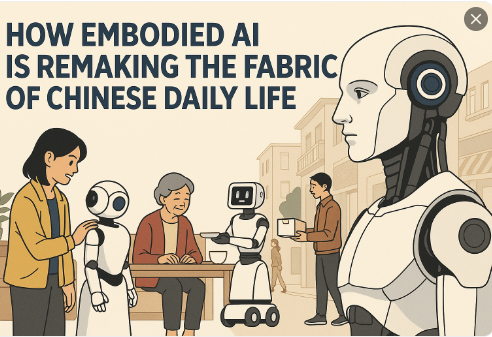The Rise of the Steel Collar Workforce
China stands at the forefront of a significant technological shift: the increasing integration of “embodied AI” into the daily lives of its citizens. This isn’t just about algorithms processing data in the cloud; it’s about artificial intelligence taking physical form, interacting with the world and its inhabitants in tangible ways. Consequently, we are witnessing the deployment of humanoid robots in various sectors, moving beyond the confines of the traditional factory floor and entering spaces previously occupied solely by humans.
These humanoid workers, often developed and refined through sophisticated AI app development services, are designed to perform a range of tasks. In hospitals, they assist nurses with patient care, delivering medications and monitoring vital signs. Within the hospitality industry, they greet guests, provide information, and even serve meals. Furthermore, retail environments now feature robotic assistants that guide shoppers, manage inventory, and process transactions. This burgeoning “steel-collar workforce” promises increased efficiency and productivity, but also raises profound questions about the future of human labor and the evolving relationship between people and machines.
Eyes Everywhere
Alongside humanoid workers, another prominent manifestation of embodied AI in China is the proliferation of autonomous surveillance technologies. These are not merely static cameras; instead, they are sophisticated “surveillance buggies” and drones equipped with advanced AI capabilities, including facial recognition, object detection, and behavioral analysis. Consequently, these mobile surveillance units can patrol public spaces, identify individuals of interest, and even predict potential security threats.
The deployment of these autonomous surveillance systems is driven by a desire for enhanced public safety and social stability. Proponents argue that these technologies can deter crime, assist law enforcement, and create a more secure environment for citizens. However, the pervasive nature of this surveillance also sparks considerable debate regarding privacy rights, civil liberties, and the potential for misuse of such powerful tools. The ethical implications of a society under constant AI-powered observation are becoming increasingly central to public discourse.
Smart Cities, Intelligent Living
The integration of embodied AI extends beyond individual robots and surveillance units; it is fundamentally reshaping the very infrastructure of Chinese cities. Smart city initiatives are leveraging AI app development services to create interconnected urban environments where various systems – from transportation and energy management to public services and security – are optimized through intelligent automation.
Consider, for instance, the advancements in autonomous vehicles. Self-driving buses and taxis are being tested and deployed in various Chinese cities, promising to revolutionize transportation, reduce traffic congestion, and enhance road safety. Moreover, AI-powered traffic management systems analyze real-time data to optimize traffic flow, adjust traffic light timings, and even predict potential bottlenecks. This interconnected web of intelligent systems aims to create more efficient, sustainable, and livable urban spaces for China’s vast population.
The Engine of Innovation
The rapid proliferation of embodied AI in China is inextricably linked to the flourishing ecosystem of AI app development services. These companies and research institutions are the driving force behind the creation of the sophisticated algorithms, software, and hardware that power humanoid robots, autonomous surveillance systems, and smart city infrastructure.
These services encompass a wide range of expertise, from developing complex machine learning models and computer vision algorithms to designing intuitive user interfaces and integrating AI into physical hardware. The demand for skilled AI developers is immense, and the Chinese government has made significant investments in fostering innovation and talent development in this crucial sector. This focus on nurturing AI app development services ensures a continuous pipeline of advancements that further accelerate the deployment and sophistication of embodied AI across various aspects of Chinese society.
Transforming Industries
While the initial applications of robotics and AI were heavily concentrated in manufacturing, embodied AI is now permeating a diverse range of industries in China. Agriculture is witnessing the deployment of robotic harvesters and drones that can monitor crops, optimize irrigation, and even identify and address plant diseases with precision. In logistics, autonomous delivery vehicles and warehouse robots are streamlining supply chains and reducing labor costs.
Furthermore, the healthcare sector is undergoing a significant transformation with the introduction of robotic surgery assistants, AI-powered diagnostic tools, and humanoid robots providing patient care. Even the education sector is exploring the potential of embodied AI, with robots being used as teaching assistants and interactive learning companions. This widespread adoption across diverse sectors highlights the versatility and transformative potential of embodied AI, moving it far beyond its traditional industrial applications.
The Human-Machine Interface
As embodied AI becomes more prevalent, the nature of human-machine interaction is undergoing a profound evolution. We are moving beyond simple commands and interfaces to a world where humans and AI-powered machines coexist and collaborate in increasingly complex ways. This necessitates a deeper understanding of how humans perceive, interact with, and trust these embodied AI systems.
Researchers and AI app development services are actively working on creating more intuitive and natural forms of interaction. This includes developing robots with more human-like movements and expressions, as well as designing interfaces that allow for seamless communication through voice, gestures, and even emotional cues. The goal is to create embodied AI systems that can effectively understand and respond to human needs and intentions, fostering more seamless and productive collaborations.
The rapid advancement and deployment of embodied AI in China inevitably raise significant ethical considerations. Questions surrounding data privacy, algorithmic bias, job displacement, and the potential for autonomous systems to make critical decisions without human oversight are becoming increasingly urgent.
The pervasive surveillance capabilities of embodied AI systems necessitate robust legal and ethical frameworks to protect individual privacy and prevent potential abuses. Furthermore, as humanoid robots become more sophisticated, it is crucial to address the ethical implications of their interactions with humans, ensuring safety, respect, and accountability. Open discussions and the development of clear ethical guidelines are essential to navigate this complex landscape responsibly and ensure that the benefits of embodied AI are realized while mitigating potential risks.
Global Implications and the Chinese Trajectory
China’s rapid advancements in embodied AI and its widespread deployment have significant global implications. The technological innovations and the societal adaptations occurring within China are likely to influence the development and adoption of embodied AI in other countries. The scale and speed of China’s advancements offer valuable insights into the potential benefits and challenges associated with this transformative technology.
Other nations are closely observing China’s approach, analyzing its successes and challenges as they formulate their own strategies for integrating AI into their economies and societies. The trajectory of embodied AI in China serves as a compelling case study for the world, highlighting the profound ways in which AI is poised to reshape daily life on a global scale. The insights gained from China’s experience will undoubtedly inform the future direction of AI research, development, and deployment worldwide.
The Future Embodied
Looking ahead, the integration of embodied AI into Chinese daily life is only set to deepen and expand. We can anticipate even more sophisticated humanoid robots performing increasingly complex tasks, more pervasive and intelligent autonomous surveillance systems, and smart cities that are truly responsive to the needs of their inhabitants. The continued innovation driven by AI app development services will undoubtedly unlock new applications and capabilities that we can only begin to imagine.
The ultimate shape of this future remains to be seen. Will it be a seamless symbiosis between humans and intelligent machines, where embodied AI enhances our lives and solves pressing societal challenges? Or will it present unforeseen challenges related to autonomy, control, and the very definition of what it means to be human? The answers to these questions will be shaped by the choices we make today as we navigate this era of rapid technological transformation.
Read More: How Generative AI is Transforming The Gaming World






























































